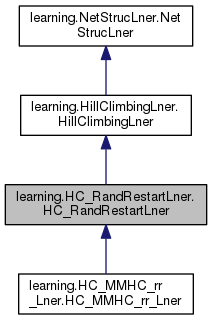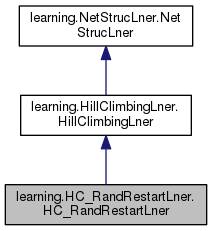|
| def | __init__ (self, states_df, score_type, max_num_mtries, num_starts=10, ess=1.0, verbose=False, vtx_to_states=None) |
| |
| def | restart (self, mtry_num) |
| |
| def | cache_this (self, move, score_change) |
| |
| def | empty_cache (self) |
| |
| def | __init__ (self, states_df, score_type, max_num_mtries, ess=1.0, verbose=False, vtx_to_states=None) |
| |
| def | climb (self) |
| |
| def | do_move (self, move, score_change, do_finish=True) |
| |
| def | refresh_nx_graph (self) |
| |
| def | would_create_cycle (self, move) |
| |
| def | move_approved (self, move) |
| |
| def | finish_do_move (self, move) |
| |
| def | restart (self, mtry_num) |
| |
| def | cache_this (self, move, score_change) |
| |
| def | empty_cache (self) |
| |
| def | __init__ (self, is_quantum, states_df, vtx_to_states=None) |
| |
| def | fill_bnet_with_parents (self, vtx_to_parents) |
| |
HC_RandRestartLner (Hill Climbing Random Restart Learner) adds to its
parent class HillClimbinmgLner a restart() function for random restarts.
Once a local maximum is reached, a random move ('restart') is made and
then from that new starting point the system is again driven towards a
possibly new local maximum. One can specify the number of random starts
desired. The local maximum with the highest score is selected at the end.
References
----------
1. Nicholas Cullen neuroBN at github
Attributes
----------
is_quantum : bool
True for quantum bnets amd False for classical bnets
bnet : BayesNet
a BayesNet in which we store what is learned
states_df : pandas.DataFrame
a Pandas DataFrame with training data. column = node and row =
sample. Each row/sample gives the state of the col/node.
ord_nodes : list[DirectedNode]
a list of DirectedNode's named and in the same order as the column
labels of self.states_df.
max_num_mtries : int
maximum number of move tries
nx_graph : networkx.DiGraph
a networkx directed graph used to store arrows
score_type : str
score type, either 'LL', 'BIC, 'AIC', 'BDEU' or 'K2'
scorer : NetStrucScorer
object of NetStrucScorer class that keeps a running record of scores
verbose : bool
True for this prints a running commentary to console
vertices : list[str]
list of vertices (node names). Same as states_df.columns
vtx_to_parents : dict[str, list[str]]
dictionary mapping each vertex to a list of its parents's names
mcache : list[tuple[str, str, str]]
a list that stores all moves of a try. This list is cleared at
beginning of each try.
score_ch_cache : list[tuple[float, float, float]]
A list that stores the score changes of each move of a try. Score
changes here are given as a 3-tuple of 3 floats, (beg_score_ch,
end_score_ch, tot_score_ch).
best_start_graph : networkx.DiGraph
best_start_score : float
Each time restart() function is called, the current tot score is
compared with best_start_score, and if it is higher, then both the
current nx_graph and its score are stored in best_start_graph and
best_start_score.
cur_start : int
current start. Increases by one every time restart() is called.
num_starts : int
number of starts. Number of times minus 1 that restart function is
called.
| def learning.HC_RandRestartLner.HC_RandRestartLner.restart |
( |
|
self, |
|
|
|
mtry_num |
|
) |
| |
This function takes in mtry_num and returns (restart_approved,
0). Zero is intended to be the next mtry_num, so mtry_num is set to
zero. Also the cur_start num is increased by one. All restarts are
approved as long as they don't exceed num_starts in number.
The cur total score is compared with best_start_score and it is
higher, then current nx_graph and its score are stored as best so far.
The function selects uniformly at random a move from mcache (mcache
is a list of all non-optimal moves of last try, and score_ch_cache
is a list of the score changes of those non-optimal moves). This
random move is submitted to do_move(), so it is performed regardless
of its non-optimality. The hope is that this random restart will
carry the system from the attractor basin of the current local max,
to the attractor basin of another local max.
Parameters
---------
mtry_num : int
Returns
-------
bool, int




 Public Member Functions inherited from learning.HillClimbingLner.HillClimbingLner
Public Member Functions inherited from learning.HillClimbingLner.HillClimbingLner Public Member Functions inherited from learning.NetStrucLner.NetStrucLner
Public Member Functions inherited from learning.NetStrucLner.NetStrucLner Public Attributes inherited from learning.HillClimbingLner.HillClimbingLner
Public Attributes inherited from learning.HillClimbingLner.HillClimbingLner Public Attributes inherited from learning.NetStrucLner.NetStrucLner
Public Attributes inherited from learning.NetStrucLner.NetStrucLner Static Public Member Functions inherited from learning.HillClimbingLner.HillClimbingLner
Static Public Member Functions inherited from learning.HillClimbingLner.HillClimbingLner Static Public Member Functions inherited from learning.NetStrucLner.NetStrucLner
Static Public Member Functions inherited from learning.NetStrucLner.NetStrucLner 1.8.11
1.8.11